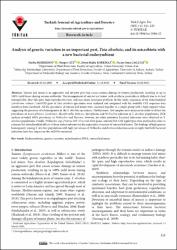| dc.contributor.author | Mehrkhou, Fariba | |
| dc.contributor.author | Korkmaz, Ertan Mahir | |
| dc.contributor.author | Çağatay, Naciye Sena | |
| dc.date.accessioned | 2022-05-17T10:46:18Z | |
| dc.date.available | 2022-05-17T10:46:18Z | |
| dc.date.issued | 10/02/2021 | tr |
| dc.identifier.citation | Mehrkhou, F. , Guz, N. , Korkmaz, E. M. & Cagatay, N. S. (2021). Analysis of genetic variation in an important pest, Tuta absoluta, and its microbiota with a new bacterial endosymbiont . Turkish Journal of Agriculture and Forestry , 45 (1) , 111-123. | tr |
| dc.identifier.uri | https://dergipark.org.tr/en/download/article-file/1783473 | |
| dc.identifier.uri | https://hdl.handle.net/20.500.12418/13173 | |
| dc.description.abstract | Tomato leaf miner is an aggressive and invasive pest that causes serious damage in tomato production, resulting in up to
100% yield losses during serious outbreaks. The management of tomato leaf miner with synthetic pesticides is difficult due to its leaf
mining habit, short life span, high reproductive rates, and insecticide resistance problem. In this study, sequences of the mitochondrial
cytochrome oxidase I (mtCOI) gene of Tuta absoluta specimens were analyzed and compared with the available COI sequence data
members from GenBank. All the specimens of tomato leaf miner were clustered together in a single group with a high support value,
suggesting the presence of a homogeneity in the T. absoluta specimens. Furthermore, 164 samples were analyzed in order to detect the
prevalence of Arsenophonus, Cardinium, Hamiltonella, Pantoea, Spiroplasma,and Wolbachia infection in T. absoluta populations. PCR
analysis revealed 100% prevalence of Wolbachia and Pantoea; however, no other symbiotic bacterial infections were observed in T.
absoluta populations. Finally, Wolbachia wsp, Pantoea 16S ribosomal RNA genes, and mtDNA COI haplotypes were analyzed in order to
estimate the mitochondrial effects of these endosymbionts on the population structure of tomato leaf miner. The findings of high genetic
homogeneity among T. absoluta populations with high prevalence of Wolbachia and Pantoea infections seem to imply that both bacterial
infections have less impact on the mtDNA variations. | tr |
| dc.language.iso | eng | tr |
| dc.publisher | Turkish Journal of Agriculture and Forestry | tr |
| dc.relation.isversionof | doi:10.3906/tar-2006-12 | tr |
| dc.rights | info:eu-repo/semantics/openAccess | tr |
| dc.subject | Endosymbionts, genetic variation, mitochondrial DNA, tomato leaf miner | tr |
| dc.title | Analysis of genetic variation in an important pest, Tuta absoluta, and its microbiota with a new bacterial endosymbiont | tr |
| dc.type | article | tr |
| dc.relation.journal | TUBİTAK | tr |
| dc.contributor.department | Fen Fakültesi | tr |
| dc.contributor.authorID | https://orcid.org/ 0000-0003-0699-1354 | tr |
| dc.identifier.volume | 45 | tr |
| dc.identifier.issue | 1 | tr |
| dc.identifier.endpage | 123 | tr |
| dc.identifier.startpage | 111 | tr |
| dc.relation.publicationcategory | Ulusal Hakemli Dergide Makale - Kurum Öğretim Elemanı | tr |















